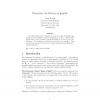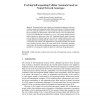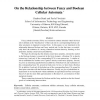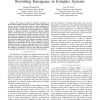109
Voted
CORR
2012
Springer
13 years 8 months ago
2012
Springer
We define the harmonic evolution of states of a graph by iterative application of the harmonic operator (Laplacian over Z2). This provides graphs with a new geometric context and...
128
Voted
HISB
2011
13 years 12 months ago
2011
— This paper presents a new cellular automata-based unsupervised image segmentation technique that is motivated by the interactive grow-cut algorithm. In contrast to the traditio...
218
Voted
IWSOS
2011
Springer
14 years 3 months ago
2011
Springer
Abstract This paper depicts and evaluates an evolutionary design process for generating a complex self-organizing multicellular system based on Cellular Automata (CA). We extend th...
143
Voted
NABIC
2010
14 years 7 months ago
2010
A new design method for Cellular automata (CA) rules are described. We have already proposed a method for designing the transition rules of two-dimensional 256-state CA for graysca...
0
posts
with
0
views
0
views
Computer Science Laboratory (LCCOMP)
http://uncomp.uwe.ac.uk/LCCOMP/
116
click to vote
TCS
2011
14 years 7 months ago
2011
Fuzzy cellular automata (FCA) are continuous cellular automata where the local rule is defined as the “fuzzification" of the local rule of a corresponding Boolean cellula...
113
click to vote
CORR
2011
Springer
14 years 7 months ago
2011
Springer
—We present a method to eliminate redundancy in the transition tables of Boolean automata: schema redescription with two symbols. One symbol is used to capture redundancy of indi...
108
Voted
CORR
2011
Springer
14 years 7 months ago
2011
Springer
We study cellular automata with respect to a new communication complexity problem: each of two players know half of some finite word, and must be able to tell whether the state o...
105
click to vote
FUIN
2010
14 years 9 months ago
2010
Abstract. Cellular automata have rich computational properties and, at the same time, provide plausible models of physics-like computation. We study decidability issues in the phas...
92
Voted
CORR
2010
Springer
14 years 9 months ago
2010
Springer
In programming language semantics, it has proved to be fruitful to analyze context-dependent notions of computation, e.g., dataflow computation and attribute grammars, using comona...






